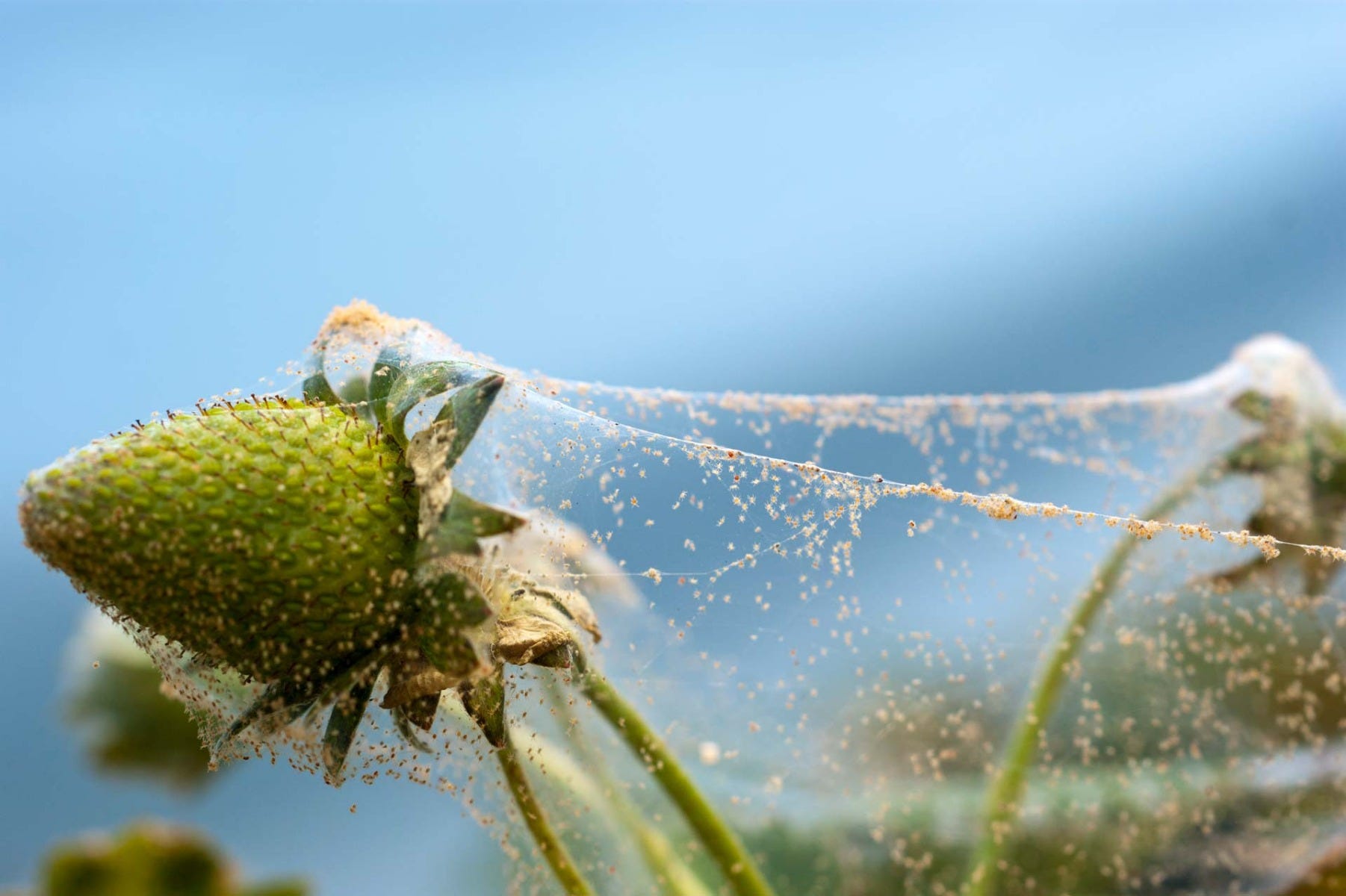
The most destructive pests in an indoor garden may be the least noticeable. Spider mites, mealybugs, scale, and other insects do their damage in the root zone or under the cover of the leafy canopy. Here’s a guide to help you identify and eliminate them without poisons or other harsh chemicals.
Spider Mites

Signs of trouble: The tiny sap suckers are one of the most destructive pests of indoor crops. Their silky webs on the undersides of leaves are the most visible sign of infestation, but you may also notice stippling (small white spots) on leaves.
Where to look: Check beneath the leaves, especially where the branches meet the stems, for the white webbing. The pests are miniscule, but with a magnifying glass you can see them as small black specks.
What they look like: Like other members of the arachnid family, spider mites have eight legs and no antennae.
What to do: A shower with a steady stream of water can often wash spider mites off plants. For a heavy infestation, spray the pests with insecticidal soap blended with pyrethrin (a natural bug killer made from chrysanthemums).
For a heavy infestation, spray the pests with insecticidal soap blended with pyrethrin (a natural bug killer made from chrysanthemums).
Root Aphids
![Root aphid infestation Root aphids in garden]()
Signs of trouble: Curled, yellowing, or distorted leaves and stunted shoots are the symptoms of a root aphid infestation. Aphids produce large quantities of a sticky excretion known as honeydew, which turns into black mold spots on stems and roots.
Where to look: Root aphids thrive in rock wool, clay pellets, and soil mixes, where they find shelter as they suck juices from roots. Aphids often feed in dense groups and do not move rapidly when disturbed.
What they look like: The small, pear-shaped insects with long legs and antennae may be green, yellow, brown, red, or black depending on the species. Most types have a pair of tube-like structures called cornicles on their back end. The adults are usually wingless.
What to do: Insecticidal soap sprays dissolve the protective coating on aphids’ outer shell. Neem oil concentrate, made from the seeds of a tree native to India, disrupts the pests’ hormonal balance and keeps them from molting. It also reduces insect feeding and acts as a repellent. After using either of these treatments, be sure to flush your feeding system thoroughly with water so the roots are rinsed clean.
Scale
![Scale infestation Scale in garden]()
Signs of trouble: When no insects are in sight and the plants are stunted with flimsy stems and yellow leaves that then drop, sap-sucking scale are often the culprit.
Where to look: Check the stems and undersides of leaves for brown or grayish-white waxy bumps. They’re most common on the main stem, close to leaf cover where they are not readily noticed.
What they look like: Females and nymphs are circular or oval-shaped and wingless, and they lack a separate head or other easily recognizable body parts—they really just look like a waxy growth. The adults stay in one place as they suck away the vital juices inside plant stems. Their nymphs have a brief crawling stage before they too eventually become stationary.
What to do: Insecticidal soap sprays block the pests’ breathing pores and dissolve their protective coating, leaving them to dehydrate and die. Scale are very resilient, and you may need to spray affected plants three times, about a week apart, to be sure you’ve eliminated all of the adults and nymphs.
Symphylids
![Symphilid infestation Symphilids in garden]()
Signs of trouble: A pest of soil only (they’re not found in water-only hydroponic systems), symphylids cause plants to die mysteriously because they live entirely underground, relentlessly chewing through roots.
Where to look: You can see these tiny wormlike pests when you rapidly water the soil because they will float up.
What they look like: Symphylids look a lot like whitish mini centipedes. They’re less than a 1/2 inch long, with 12 legs and 2 long antennae.
What to do: Discard any plant that has been infested so that you keep the problem from spreading in your indoor garden. Protect plants that have not yet been afflicted with a drench of neem oil concentrate.
Mealybugs
![Mealy bug infestation Mealy bugs in garden]()
Signs of trouble: Like other sap-sucking insects, mealybugs cause leaves to curl and turn yellow. Each mealybug is very small, but in large clusters, they can make your plants’ stems look like they are covered in cotton.
Where to look: Mealybugs cluster at the base of plants’ stems and in the crevices where the branches meet the stem.
What they look like: Soft-bodied insects that look like they are covered in cotton, mealybugs are just 2 to 4 millimeters long (less than 1/5 inch). The females have no wings. They suck the sap from plants through plant-piercing mouthparts.
What to do: Spray them with a soap that contains potassium salts of fatty acids, which penetrates the pests’ cottony layer and dehydrates them.
Did You Battle Any Of These Pests?
Hopefully your infestation is under control at this point or at least well underway. Safer® Brand offers a variety of products, including insecticides, that are compliant for use in organic gardening. Visit our Facebook page to share your pest control or gardening stories and pictures with other gardening enthusiasts or sign up for our e-Newsletter to get exclusive offers on the products you love and notifications about new or upcoming articles. Another great resource is the Safer® Brand Learning Center. There are lots of articles, tips, and interesting facts that will help answer questions and transform you into a better gardener.



